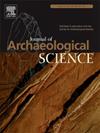Stone disc production at Pincevent (France) reveals versatile uses of colouring materials in the Late Magdalenian
IF 2.6
1区 地球科学
Q1 ANTHROPOLOGY
引用次数: 0
Abstract
Level IV0 at Pincevent, dating from the Late Magdalenian (15-14 ka cal BP), has revealed a singular assemblage of more than 400 artefacts in colouring materials, including a unique series of perforated discs. This unusual occurrence of shaped colouring materials extends the diversity of uses and functions of these mineral resources. Using a combination of non-invasive petrographic analysis and detailed study of traces of anthropogenic modifications, we identified the nature, provenance and petrophysical properties of the rocks used, as well as the techniques employed to work them and their possible uses. The results show a variety of mineral materials employed – consisting of oolitic hematites, fine hematites, ferruginous sandstone and chalk – to produce a wide range of colours, including red and yellow as well as white. Disc shaping involves techniques adapted to mineral materials, such as knapping, as evidenced here for the first time on colouring materials. Several examples of the recycling of broken discs into new discs or into colouring powder attest to the versatile use of colouring materials and highlight their incorporation into various fields of decorative, technical and domestic activities during the Upper Palaeolithic.
平event(法国)的石盘生产揭示了在马格达莱尼晚期,着色材料的多种用途
平event的IV0层可以追溯到晚马格达莱世(15-14 ka cal BP),发现了400多件着色材料的人工制品,包括一系列独特的穿孔盘。这种不寻常的形状着色材料的出现扩展了这些矿产资源的用途和功能的多样性。通过结合非侵入性岩石学分析和对人为改变痕迹的详细研究,我们确定了所用岩石的性质、来源和岩石物理性质,以及用于处理它们的技术及其可能的用途。结果显示,使用了多种矿物材料——包括鲕状赤铁矿、细赤铁矿、含铁砂岩和白垩——产生了多种颜色,包括红色、黄色和白色。圆盘成形涉及到适用于矿物材料的技术,如压扣,这是第一次在着色材料上得到证明。有几个例子证明,在旧石器时代晚期,将破碎的圆盘回收成新的圆盘或制成着色粉,证明了着色材料的用途广泛,并突出了它们在装饰、技术和家庭活动的各个领域的结合。
本文章由计算机程序翻译,如有差异,请以英文原文为准。
求助全文
约1分钟内获得全文
求助全文
来源期刊

Journal of Archaeological Science
地学-地球科学综合
CiteScore
6.10
自引率
7.10%
发文量
112
审稿时长
49 days
期刊介绍:
The Journal of Archaeological Science is aimed at archaeologists and scientists with particular interests in advancing the development and application of scientific techniques and methodologies to all areas of archaeology. This established monthly journal publishes focus articles, original research papers and major review articles, of wide archaeological significance. The journal provides an international forum for archaeologists and scientists from widely different scientific backgrounds who share a common interest in developing and applying scientific methods to inform major debates through improving the quality and reliability of scientific information derived from archaeological research.
 求助内容:
求助内容: 应助结果提醒方式:
应助结果提醒方式:


